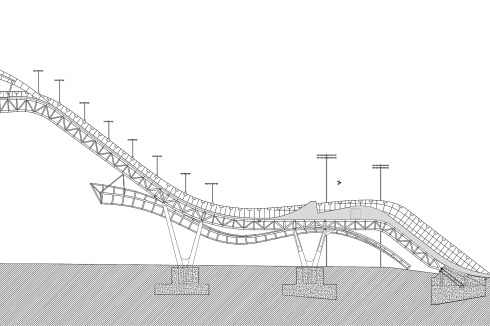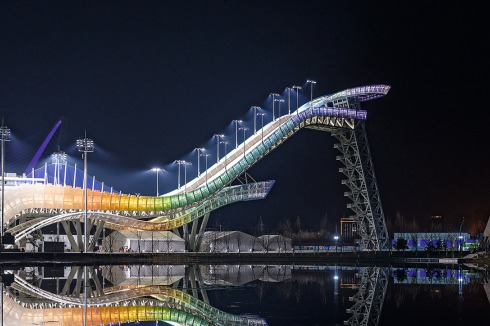IUPA 2021 - First Prize
Big Air Shougang; Atelier TeamMinus, Beijing
Text: Red.
IUPA 2021 - First Prize
Big Air Shougang; Atelier TeamMinus, Beijing
Text: Red.
The project Big Air Shougang transforms a gigantic, decommissioned steelworks into a center for sports, culture, nature, and recreation. The choice of the site as the venue for the 2022 Winter Olympics, announced in 2016, was decisive in propelling this transformation forward. The Shougang conversion strives to re-enliven the steel works, which commenced operations more than a century ago, while reconnecting the city with the Yongding River and restoring the heavily damaged natural environment. The colorful, eye-catching Big Air Slope emblematizes the young, dynamic sport, and can alter its profile to accommodate further sport types. The target area and part of the stadium, with its 5000 seats, are buried in the lake. For the adaptive reutilization of the former oxygen factory as a service building for spectators in Beijing in 2022, and as a sports and recreational facility, the original structure of the large factory building has been preserved and new floors added. Preserved as well is the structure of the ventilation station, while structural interventions into the four additional factory buildings accommodate a multifarious mix of utilizations. Additional adjacent industrial structures, among them the fractionation tower, numerous storage cylinders and spheres, have been preserved, decontaminated, and refurbished. Even after the Winter Olympics, this event venue will remain a stimulating and intriguing destination for visitors, enhancing the attractiveness of the region as a whole.
Zhang Li, Big Air Shougang is located on the industrial heritage site of a former steel plant in West Beijing. How is it situated in relation to the city?
Beijing is growing. When I was born in 1970, the city was about one fifth its present size. Shougang is 20 kilometres from the centre, and is regarded as a separate region, but in practical terms, it has been absorbed by the city. The masterplan of Beijing is made up of the concentric circles of the ring roads; Shougang – 10 square kilometres of empty factories – is located between the fifth and sixth rings.
Beijing is growing. When I was born in 1970, the city was about one fifth its present size. Shougang is 20 kilometres from the centre, and is regarded as a separate region, but in practical terms, it has been absorbed by the city. The masterplan of Beijing is made up of the concentric circles of the ring roads; Shougang – 10 square kilometres of empty factories – is located between the fifth and sixth rings.
What does this place mean to people?
Shougang is the capital city’s steel plant, built in the late 19th century as the first factory on this scale. In the 1950s, it was an iconic symbol of China as a rising industrial power. Since the 1980s, it hasn’t been regarded as a pioneering industry, and in 2010, production was moved to Hebei Province. But the place means a lot for the memory of industrialisation in China.
Shougang is the capital city’s steel plant, built in the late 19th century as the first factory on this scale. In the 1950s, it was an iconic symbol of China as a rising industrial power. Since the 1980s, it hasn’t been regarded as a pioneering industry, and in 2010, production was moved to Hebei Province. But the place means a lot for the memory of industrialisation in China.
The development is not intended solely for the Winter Olympics?
The transformation is taking place in three parts: the first is centred around the Big Air venue, along with the cooling towers and the cooling lake. It includes the redevelopment along the perimeter of the lake, as well as the conversion of an oxygen factory. The second part comprises office buildings for the organisation committee. The third part consists of training centres for the Chinese national winter sports team, including skating, ice hockey and other sports. Whereas the reuse of industrial heritage is a familiar theme, the incorporation of an Olympic competition venue is new. This gathering of resources and the tension that accompanies this international event helps to drive the overall renovation and reuse of the site and its reintegration into the city.
The transformation is taking place in three parts: the first is centred around the Big Air venue, along with the cooling towers and the cooling lake. It includes the redevelopment along the perimeter of the lake, as well as the conversion of an oxygen factory. The second part comprises office buildings for the organisation committee. The third part consists of training centres for the Chinese national winter sports team, including skating, ice hockey and other sports. Whereas the reuse of industrial heritage is a familiar theme, the incorporation of an Olympic competition venue is new. This gathering of resources and the tension that accompanies this international event helps to drive the overall renovation and reuse of the site and its reintegration into the city.
Do you see the project less as architecture or event and more as creating a public space?
The game is just a temporary, short-lived event. The Olympic Games are a big attraction in China and can initiate the impetus to reintroduce life into a place that was formerly used by industry, not residents. To demonstrate its value as a project, we need to have viable urban life here in the coming years. To be a meaningful destination, a public space has to meet what we call the “two-and-a-half hours principle”. Meaning the potential to attract ordinary city-dwellers who will spend two and a half hours in a particular place. To do this, you need multiple kinds of activity: leisure, walking, seating, views, spaces for meeting and the exchange of information. The combination of such experiences in a certain rhythm adds up to “two and a half hours”.
The game is just a temporary, short-lived event. The Olympic Games are a big attraction in China and can initiate the impetus to reintroduce life into a place that was formerly used by industry, not residents. To demonstrate its value as a project, we need to have viable urban life here in the coming years. To be a meaningful destination, a public space has to meet what we call the “two-and-a-half hours principle”. Meaning the potential to attract ordinary city-dwellers who will spend two and a half hours in a particular place. To do this, you need multiple kinds of activity: leisure, walking, seating, views, spaces for meeting and the exchange of information. The combination of such experiences in a certain rhythm adds up to “two and a half hours”.
Beyond the 2022 Winter Olympics, how will Beijing benefit from the project?
On the slope alone, we cannot create a “two and a half hour” experience. Ordinary people cannot use it. But we do achieve this with the renovated oxygen factory, which is very much like a district, with industrial cylinders and modern buildings in between. It has been converted into creative industry office and retail space and cafes. And along the lake, we have created various facilities and open spaces that offer views and seating places as well as walking paths that extend onto the water.
On the slope alone, we cannot create a “two and a half hour” experience. Ordinary people cannot use it. But we do achieve this with the renovated oxygen factory, which is very much like a district, with industrial cylinders and modern buildings in between. It has been converted into creative industry office and retail space and cafes. And along the lake, we have created various facilities and open spaces that offer views and seating places as well as walking paths that extend onto the water.
How did the abandoned industrial structures inform the project?
To host urban events and adapt to the daily lives of users, you need to break down the scale and divide spaces into smaller, interlinked ones. And you need to accommodate flexibility. Such spaces should serve multiple purposes and be adaptable to change while responding to the human scale and should respect current modes through which people work and live together.
To host urban events and adapt to the daily lives of users, you need to break down the scale and divide spaces into smaller, interlinked ones. And you need to accommodate flexibility. Such spaces should serve multiple purposes and be adaptable to change while responding to the human scale and should respect current modes through which people work and live together.
The project relies on reuse as opposed to demolition; the slope is dismountable. What are your thoughts on sustainability?
Regarding the conversion, we wanted to retain as much of the existing structure as possible, although it is more expensive, but this financial investment has resulted in environmental gains. The new volumes, which are set perpendicular to the original structure, were added without giving them too much additional load. Furthermore, every part of the slope is reusable. It is assembled as a prefab structure and can be completely disassembled. We always try to think long-term, not to design simply for specific programmes. If you only design for a specific programme, it becomes outdated by the time it’s been built.
Regarding the conversion, we wanted to retain as much of the existing structure as possible, although it is more expensive, but this financial investment has resulted in environmental gains. The new volumes, which are set perpendicular to the original structure, were added without giving them too much additional load. Furthermore, every part of the slope is reusable. It is assembled as a prefab structure and can be completely disassembled. We always try to think long-term, not to design simply for specific programmes. If you only design for a specific programme, it becomes outdated by the time it’s been built.














0 Kommentare